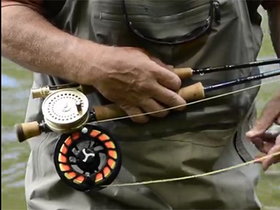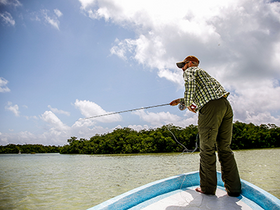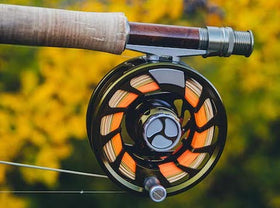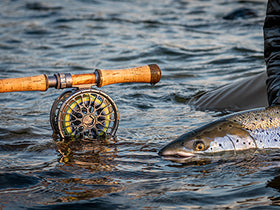A buggy nymph, great for generically for imitating scud and mayfly.
John has provided the following notes on his fly:
This fly was devised about forty-five years ago at our camp at Beginner’s Bay at Penstock Lagoon to be specifically used when polaroiding large stick caddis feeding trout in the shallows of this famous water. The body was comprised of a dubbed blend of seal’s fur - about 50% brown, 25% olive green with equal quantities of black, yellow and red making up the residue. This blend produced a natural hue.
My first attempt at the fly had a skinny, slightly tapered body but a relatively normal thorax. I had some success with this original pattern but found that it worked better after it had caught a few trout and the thorax became sparser.I then started tying the fly with its characteristic skinny thorax. I also clip the loose seal’s fur and compress the body with my thumb and finger so as to accentuate its thin appearance.
This is not a “magic” fly. Magic flies don’t exist. For three main reasons it is a useful fly to use when polaroiding shallow lagoons. It is a light fly and doesn’t sink quickly. It is frustrating to make a good presentation to a cruising fish only to find that the fly has sunk and snagged something on the bottom. I have never had a trout take a snagged fly and my almost invariable experience is that if you pull the fly free, the trout is spooked. It is equally frustrating if the fly does not sink. This nymph will sink, even if you have not made a presentation for hours on a hot, dry day. And finally, the trout seem to like it.
Polaroiding for cruising trout in the shallows is technically difficult. First, you must spot the trout within sufficient time to make a good presentation. If you cannot do this, all is lost. And it is essential to get the first presentation right. Most of the time when wade polaroiding, you do not get the luxury of a second chance. If you do make a good presentation, you must discern if and when the trout takes the fly. If you see the white of the mouth of the trout when it is near the fly and strike you will usually connect with the fish.
If you don’t see this sign, it is more difficult. In my heyday (which was too many years ago) I developed a seventh sense and found if I instinctively struck, I usually hooked the fish. But after hooking it I would be unable to identify what it was that made me strike. Jim Allen had the same experience. A useful tip is that if you lose your vision of the fish keep the line tight and give nymph a slight twitch or two.
Often this results in a hook-up. I have also enjoyed success with this fly polaroiding the large trout of the sluggish rivers of the Monaro, the pastoral streams in the Southland of New Zealand, the famed chalk streams in Hampshire including the River Test and some of its tributaries, the San River in Poland, Brumby’s Creek, and Leake’s Lagoon on the Goulburn River.
The shallows of Lake Hawea and the South Mavora Lake provide similar fishing to that which is to be found in the shallows of the lagoons of the Tasmanian Central Plateau. This nymph is very effective on these waters on bright, sunny, windy days. As always, the key factors to success on all these waters are spotting the fish, making a good presentation, and striking at the right time. It sounds so simple. Let me assure you, it is not!
Having the right frame of mind can be as important as the technical requirements of this style of fishing. In order to succeed one needs intense self-belief and faith that sooner or later the piscatorial stars will align, and a fish will be seen and hooked. It takes a lot of faith and determination to persevered for hours on end without getting a single chance to cast at a fish. But the rewards can be great. One day at Penstock when the water was slightly turbid and the fish were few and far between, the rest of our party went to fish the hatch at Little Pine. I persevered at Penstock, had three chances for the whole day and landed a brace of trout on my nymph which weighed in at 5lbs 2oz apiece. This feat gave me an immense feeling of satisfaction that I remember to this day.





